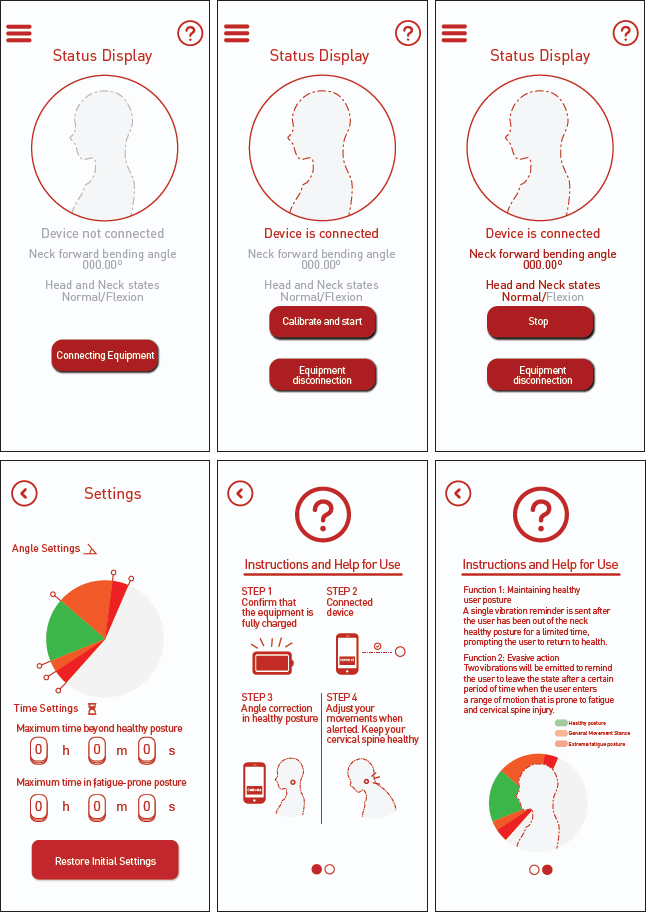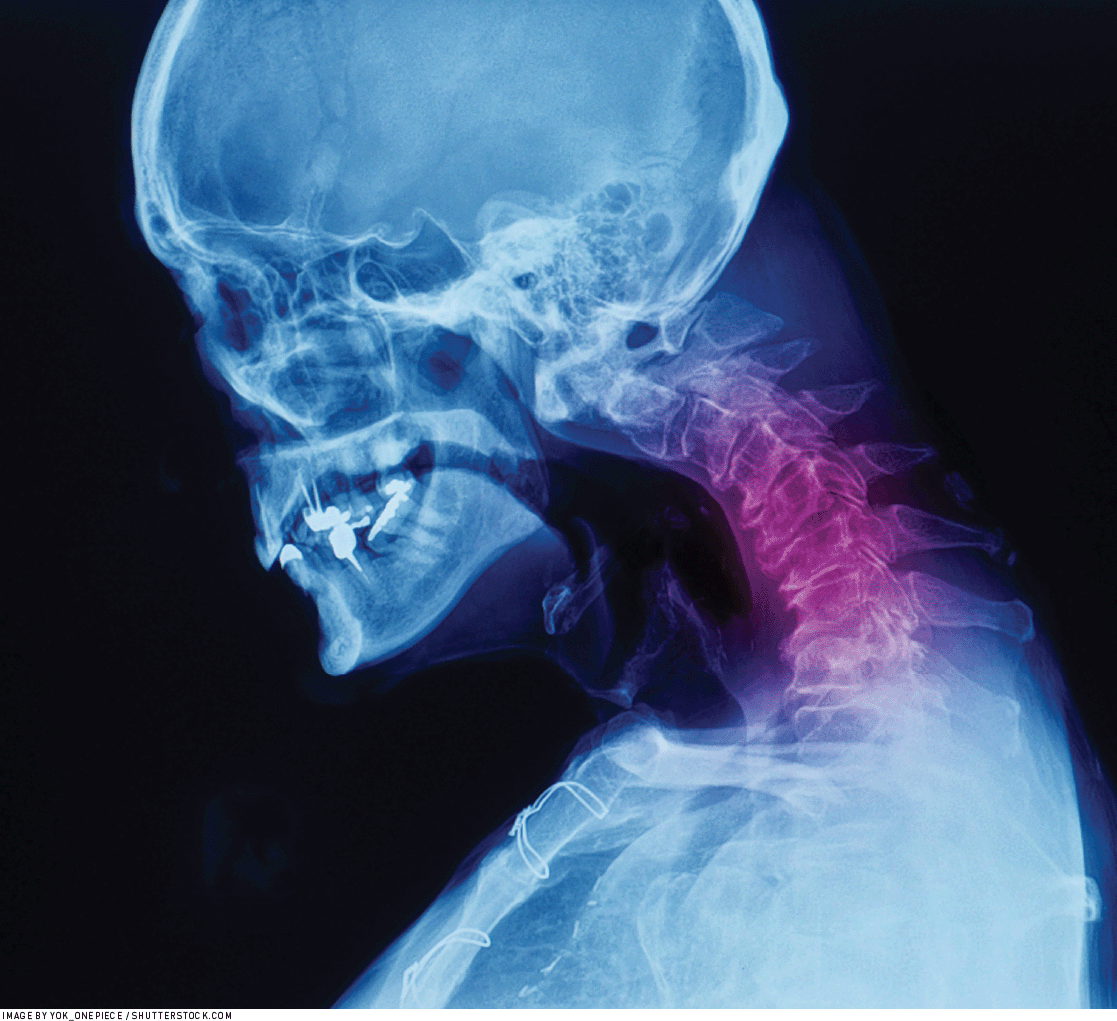Authors:
Yuqian Ji, Hemin Du, Junfeng Wang
In today's rapidly advancing tech world, people are spending more time than ever interacting with screens. Studies show a steady increase in daily smartphone usage globally. But with this rise in screen time comes a downside—repetitive or prolonged neck flexion is one of the risk factors for pain in the neck and shoulder region [1]. This issue is particularly pronounced among younger individuals, who are developing cervical spondylosis—a degenerative spinal condition affecting neck vertebrae and discs—at alarming rates.
→ Health prevention should seamlessly integrate into everyday life. The smart earring redefines traditional clinical devices by embedding precise posture monitoring within a wearable accessory.
→ Effective intervention depends on personalization and subtlety. Scientifically calibrated neck-angle thresholds, combined with timely haptic feedback, support behavior change without disrupting users' routines.
Our goal is to design solutions that make a difference, ease discomfort, and keep neck fatigue at bay. One promising avenue is through physical interaction design—a concept that encourages users to engage in healthier behaviors by interacting with devices in a way that promotes health awareness. Devices designed with this goal in mind don't just monitor posture; they actively engage users by providing real-time feedback, such as vibrations or audible reminders, nudging them toward habits that can protect their cervical spine.
Health-related products on the market generally fall into two categories: software-based solutions and physical devices. Apps such as Pomodoro Timer help users manage screen time by setting usage limits and sending reminders. Products such as fitness rings encourage movement through gamification, indirectly preventing issues like cervical strain by promoting physical activity.
Physical interaction products span a wide range of fields—healthcare, fitness, manufacturing, and even entertainment. In healthcare specifically, innovative tools are emerging to support healthier lifestyles and reduce the incidence of conditions like cervical spondylosis. These health-focused devices typically fall into two categories: wearables and desktop devices. Wearables—including smart bracelets and AI-powered glasses—collect data on physical activity, provide real-time feedback, and, in some cases, detect poor posture. For example, smart glasses can recognize neck movement patterns and prompt users to take breaks or correct their posture, helping relieve neck tension. Desktop devices guide users through neck-relieving activities with visual cues such as lights or on-screen prompts. Many incorporate gamelike elements to keep users engaged. After a set period of activity, they might suggest specific exercises and reward users for following through—making healthy habits both effective and enjoyable.
 Underlying Causes of Cervical Spondylosis
Underlying Causes of Cervical Spondylosis
Understanding why cervical spondylosis is on the rise is key to developing effective prevention strategies. While it is easy to blame the digital age, a deeper look reveals that user habits and other contributing factors are also to blame. Factors such as patient aging, extreme environments, occupational strain injuries, lifestyle habits, hormones, pharyngeal infections, sleeping positions, smoking, and diet have been identified as potential contributors. Diseases of the musculoskeletal system often result from long-term smartphone use, causing damage to fibers and muscle tone [2]. Additionally, maintaining a poor head posture consistently exerts excessive pressure on joints and muscles, leading to weakness in the deep neck muscles and subsequent changes in the neck area [3]. Excluding congenital diseases and force majeure factors, the prevention of cervical spine diseases is proposed to be based on individual daily behavior, lifestyle habits, and environmental factors.
A consultation with a spine surgeon generally results in key recommendations focused on avoiding prolonged bowing or twisting of the head, forward neck leaning, sitting for long periods of time, and unequal stress on the shoulders; maintaining a comfortable sleeping position; ensuring a daily angle of view above eye level; and engaging in physical exercise that keeps the head lifted and stretches the neck, such as badminton and swimming. These measures significantly alleviate pressure on the neck.
Building on the market's lack of active guidance for users to prevent neck problems and considering human structural characteristics, we designed a system that detects a user's neck posture and reminds them. By monitoring head tilt angle and duration of maintained posture, the system aims to correct users' neck posture and prevent interaction-induced neck fatigue. The reminders we introduced emphasize avoiding prolonged head bowing, substantial head tilting, prolonged neck tilting, and extended periods of sitting. This approach aids users in preventing cervical spine problems by promoting awareness and correction of poor neck posture.
 Determining User Posture and Defining Duration Thresholds for Bad Posture
Determining User Posture and Defining Duration Thresholds for Bad Posture
Monitoring and preventing users from prolonged bowing and tilting of the head, which constitute bad posture, is a challenge. To achieve the goal of detecting bad posture, the key is to develop an index to quantify posture and establish the angle and duration thresholds. This is essential for effective correction of bad posture and prevention of cervical spondylosis. The issue of a lowered and/or tilted head position, primarily caused by tight and overstretched neck muscles, can be effectively mitigated through real-time angle monitoring that alerts users when head-body alignment deviates from the normal range, prompting timely posture correction to relieve muscle strain. In the preliminary research phase, the threshold values we obtained were somewhat vague. To refine these values, we used experimental design to derive more accurate results.
In the experimental determination phase, the angle threshold for bad posture was established through experiments where the user's head was angled in relation to the viewing plane. Subjective scales, derived from users' completion of reading tasks, along with myoelectricity data from the neck's stressed muscles, were utilized. This involved summarizing the angle range of neck muscles that quickly fatigue and determining the fatigue time for different angle ranges. The EMG data used the last 10 seconds of amplitude change when the user confirmed fatigue as an indicator. The threshold value for bad posture was then determined based on both the angle range and the duration. This comprehensive approach ensures a more accurate assessment of bad posture and aids in the effective prevention of cervical spondylosis.
 Addressing Technical Implementation Challenges
Addressing Technical Implementation Challenges
To find an effective way to monitor and prevent poor posture—specifically prolonged neck bending or tilting—it is crucial to quantify posture and set thresholds for both angle and duration. Through experimental research, we found the specific angles and times at which neck muscles begin to fatigue. By analyzing users' posture data, we established a range of angles where fatigue sets in quickly, and we used this data to create a more accurate posture monitoring system.
Making this design a reality involves tackling several technical challenges. The key was choosing the right sensors and hardware to monitor neck posture effectively, while also keeping the device lightweight and comfortable to wear. The information acquisition module serves as the device's core, acting as the data source for the central processing system. We adopted the SCMA-800 angle sensor (Figure 1 a)) and proximity sensor. While the inclination sensor handles real-time angle monitoring, it lacks information storage capabilities. To address this, the main control board is employed to write the storage program to complete information acquisition.
 | Figure 1. a) Smart Health Earrings' angle sensor; b) Bluetooth motherboard; c) lithiumion battery. |
Given size limitations, the integration of Bluetooth and the motherboard is crucial. We chose the Seeed Studio XIAO microcontroller Bluetooth master, model Xiao ESP32C3 (Figure 1 b)). This motherboard not only encompasses all functions of the LilyPad 328 motherboard but also features a convenient Type-C connector for program compilation and charging. Power supply planning involves selecting a common, lightweight, and reusable lithium-ion battery (Figure 1 c)) to maximize battery life within size constraints. We selected a 3.7V 40mAh Li-ion battery, which has a capacity similar to that of AirPod batteries. This approach ensures practicality and efficiency in addressing the technical challenges associated with neck fatigue prevention.
 Problem of Benchmarking Wearables on the Human Body
Problem of Benchmarking Wearables on the Human Body
The initial challenge involved selecting a datum position and reference point, crucial for constraining the product's form in this interaction design. Determining the suitable wearing position of the device is paramount to ensure accurate monitoring of the user's posture. Additionally, addressing interindividual variations is necessary for proper calibration and personalized adaptability. Long-term wear accuracy and stability are crucial for adaptability in dynamic environments. Achieving a balance between sensor snugness and user comfort is essential for enhancing the overall user experience and device comfort.
Datum position and reference point. After establishing the base position, a calibration function can be integrated to address deviation issues when users wear the product. This involves measuring the relative angle after wearing the product, allowing for interaction judgment adjustments based on the deviation.
Personalized adaptation. To tackle the challenge of personalized adaptation, user-customized adjustment of response conditions can be introduced. This allows users to fine-tune and refine the most suitable interaction mode based on their preferences and comfort levels. This approach ensures a tailored and adaptable experience for users with diverse needs and preferences.
 Addressing Issues with Product form: A Comprehensive Solution
Addressing Issues with Product form: A Comprehensive Solution
The challenge of product form is viewed from two perspectives: the user's and that of the product itself. From the user's viewpoint, the product plays a decorative role, necessitating an aesthetically pleasing and tasteful form. Factors such as size and weight significantly affect the usability of the product. Customizability is also a crucial consideration. From the product's perspective, the form should align with its own structure, encompassing all modules efficiently while maintaining a small size. It must also adhere to a reasonable human-machine relationship, ensuring the wearer's comfort in terms of width, power port position, and other relevant factors.
To address the choice of shape, we conducted a brainstorming session with 50 participants. Stud earrings, hair cards, and hair bands emerged as the top choices, with studs receiving the highest number of votes. Given that studs are generally stable and less easily removed, they were adopted as the product carrier. The final choice was a magnetic earring structure, which ensures product stability on the human body, increases the force area, reduces pressure, and minimizes discomfort during close contact with the user's skin. This approach strikes a balance between user aesthetics and product functionality.
 Design Description for Smart Cervical Spine Disease Prevention Interactive Product
Design Description for Smart Cervical Spine Disease Prevention Interactive Product
The interactive product shown in Figure 2 is crafted to deliver a holistic experience in cervical spine disease prevention and protection, seamlessly integrating smart technology for posture monitoring, reminder alerts, and comfortable wear.
 | Figure 2. Exploded view of the program. |
Combining wearability with advanced posture-tracking technology, this system integrates smart jewelry and AI-driven analytics to actively prevent neck strain and promote cervical health. Its design features include:
- Magnetic earrings for secure and comfortable wear: The magnetic design ensures a secure and comfortable fit without the risk of falling off or causing discomfort.
- Real-time posture monitoring: Integrated sensors and Bluetooth technology work in harmony to monitor the wearer's neck posture and activities in real time.
- Analysis of cervical vertebrae health: The product analyzes the health of the cervical vertebrae based on the gathered sensor data, providing insightful feedback and suggestions through a dedicated mobile app.
- Reminder alerts for posture adjustment: If the wearer maintains a lowered head position for an extended period or remains inactive, the earrings employ subtle vibrations to remind the user to adjust their posture or engage in neck exercises.
- Mobile app integration (Figure 3): The accompanying mobile app displays the wearer's daily cervical angle and other relevant data. It offers tailored suggestions based on the analyzed information, contributing to a proactive approach to cervical spine health.
 | Figure 3. Interactive interface for Smart Health Earrings. |
User experience. Users benefit from a comprehensive solution that monitors their cervical spine health and actively guides them toward maintaining a correct posture and engaging in neck exercises to prevent cervical spondylosis.
Overall goal. The primary goal is to empower users with the tools and insights needed for effective cervical spine disease prevention, fostering a proactive and health-conscious lifestyle. The combination of monitoring, reminders, and comfortable wear ensures a user-friendly and effective experience.
This interactive design presents a novel approach to preventing cervical spondylosis. While the design offers valuable insights and solutions, there are limitations, particularly in its applicability to users with special needs or in diverse environments. For example, since dynamic walking affects cervical spine movement [4], the recognition of bad postures in different motion states still needs to be optimized through the introduction of new variables. Further refinement and adaptation are needed to ensure the system's effectiveness across different scenarios. Nonetheless, this research lays the groundwork for future innovations in health-related interaction design, aiming to empower users with the tools they need to protect their cervical spine and adopt healthier habits.
1. Mushroor, S., Haque, S., and Riyadh, A.A. The impact of smart phones and mobile devices on human health and life. International Journal of Community Medicine and Public Health 7, 1 (2020): 9–15; DOI: 10.18203/2394-6040.ijcmph20195825
2. Sarraf, F. and Varmazyar, S. Comparing the effect of the posture of using smartphones on head and neck angles among college students. Ergonomics 65, 12 (2022), 1631–1638; DOI: 10.1080/00140139.2022.2047229
3. Ha, S.-Y. and Sung., Y.-H. A temporary forward head posture decreases function of cervical proprioception. Journal of Exercise Rehabilitation 16, 2 (2020), 168–174; DOI:10.12965/jer.2040106.053
4. Yoon, W., Choi, S., Han, H., and Shin, G. Neck muscular load when using a smartphone while sitting, standing, and walking. Human Factors 63, 5 (2021): 868–879; DOI: 10.1177/0018720820904237
Yuqian Ji is a graduate student at Shenzhen Technology University. His research focuses on product innovation design, wearable design, and human-computer interaction. [email protected]
Hemin Du is a professor in the School of Design and Innovation at Shenzhen Technology University. He teaches a wide range of courses in industrial design and related fields. [email protected]
Junfeng Wang is a professor in the School of Design and Innovation at Shenzhen Technology University. He teaches several courses in UX and related fields. [email protected]
Copyright is held by the owners/authors. Publication rights licensed to ACM.
The Digital Library is published by the Association for Computing Machinery. Copyright © 2025 ACM, Inc.







Post Comment
No Comments Found